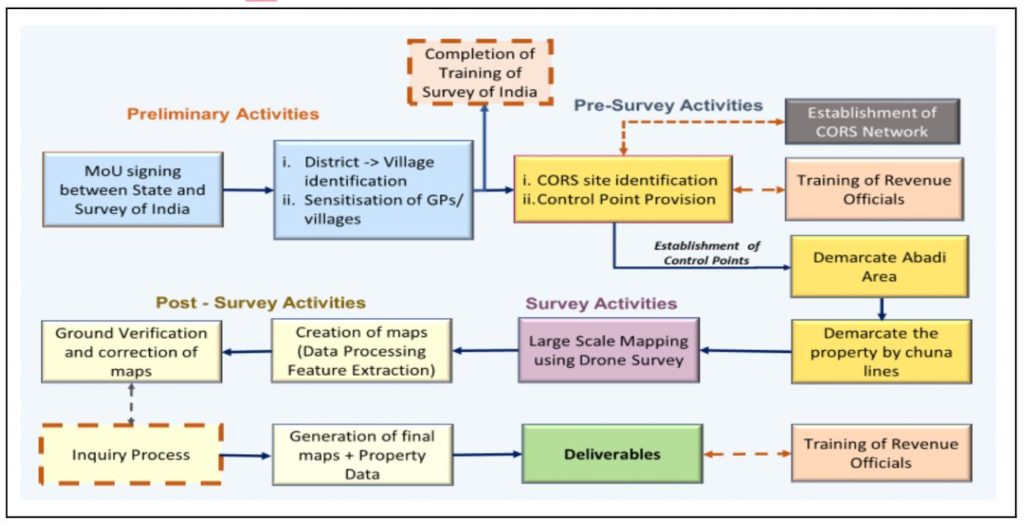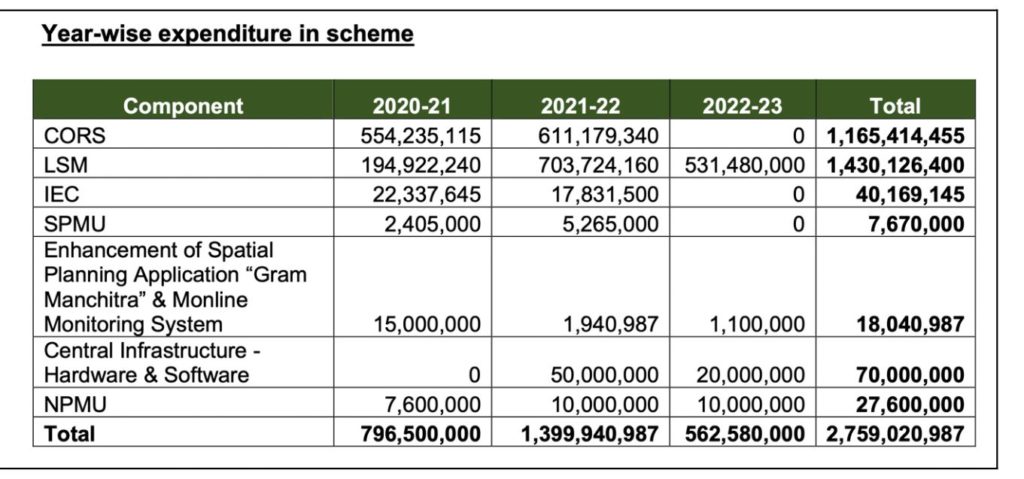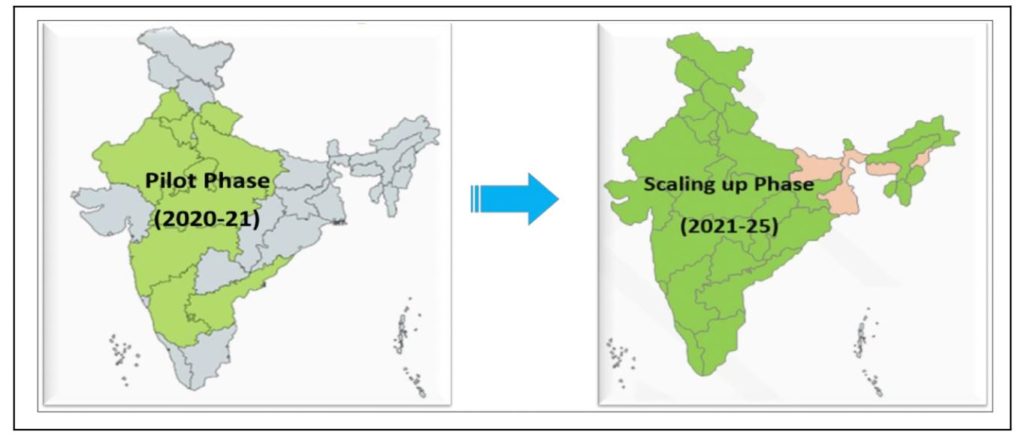The main aim of the SVAMITVA scheme is to provide an integrated property validation for Rural India. Through this scheme, the government plans to provide a ‘Record of Rights’ to every rural household owner in a rural inhabited area. What is the progress of the scheme?
Ownership of land provides security against any contingencies. Proper documentation regarding the ownership, enables a hassle-free process in securing any loans. Unclear & incomplete documentation hampers the process of securing financial aid. The situation is more common in rural areas. The SVAMITVA scheme was launched by the Government of India, to address a few of these issues related to property rights in rural areas.
What is SVAMITVA?
SVAMITVA scheme is a Central scheme launched in 2020 on the National Panchayat Raj Day i.e., 24 April. SVAMITVA stands for ‘Survey of Villages and Mapping with Improvised Technology in Village Areas’. This was initially launched as a pilot project in select states during 2020-21. The scheme was launched nationwide on 24 April 2021 after the completion of the Pilot.

The main aim of the scheme is to provide an integrated property validation for Rural India.
Through this scheme, the government resolves to enable economic progress in Rural India by providing a ‘Record of Rights” to every rural household owner in a rural inhabited area. This is planned to be achieved using Drone Technology and Continuously Operating Reference Station (CORS) technology for capturing images.
Some of the aspects that the scheme wishes to achieve include:
- facilitating monetization of properties and enabling bank loans
- reducing property-related disputes by aiding in the creation of accurate land records.
- comprehensive village-level planning through the creation of Survey infrastructure and GIS maps.
- determination of property tax etc.
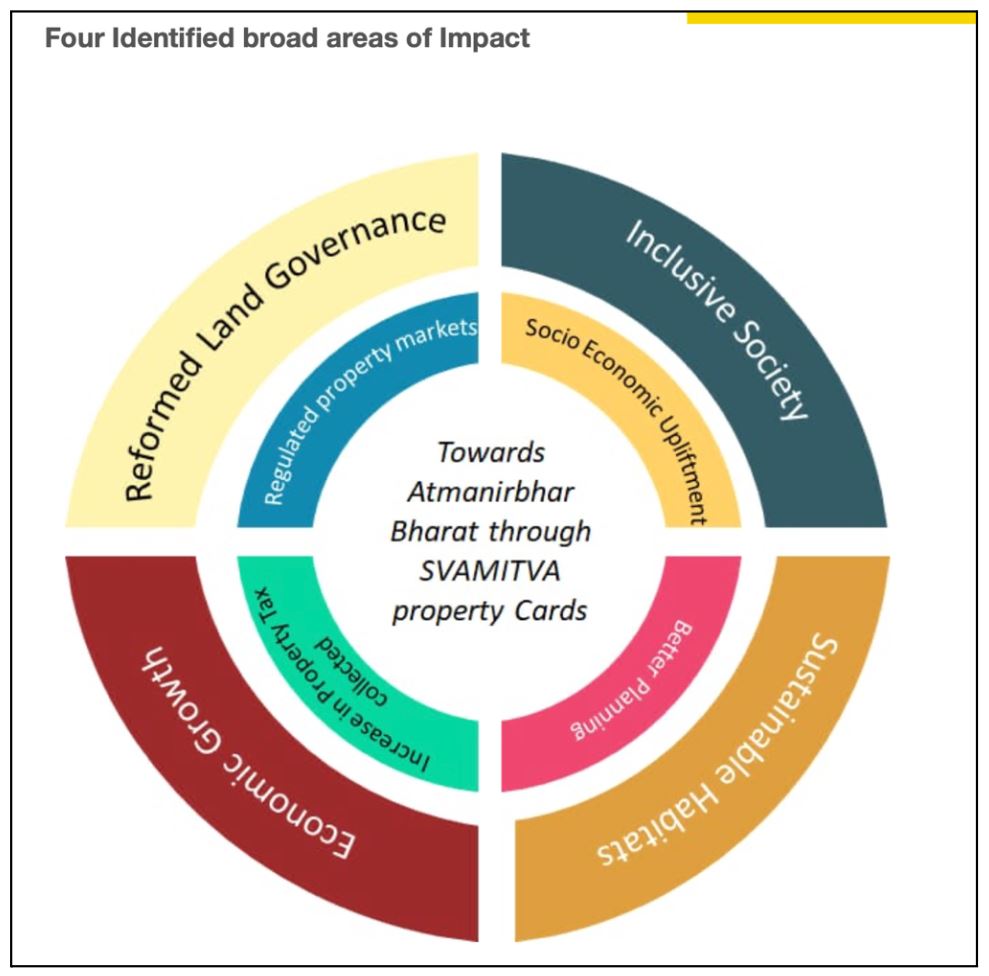
Recently, Report of the Expert Committee on the SVAMITVA Scheme was released by the Government of India’s Ministry of Panchayat Raj, which reviewed the scheme and made recommendations.
31 States have signed MoU with Survey of India for implementation of the scheme.
SVAMITVA scheme is a collaborative effort of the Ministry of Panchayati Raj, State Panchayati Raj Departments, State Revenue Departments and Survey of India. While the Ministry of Panchayat Raj is the Nodal ministry, the Survey of India is the Technological Implementation Agency.
The entire implementation of the scheme can be broadly divided into – Pre-Survey, Survey and Post-Survey activities. Pre-survey activities include preparatory activities like – signing of MOU by State & Survey of India, Identification of sites for establishing CORS, notification of village, broader demarcation of the land, training activities etc.
Survey activities include the establishment of Ground Control Points for drone surveys, capturing and processing of Images etc. Post Survey activities include verification of maps, ownership data collection from Revenue departments and Gram panchayat, review of existing documents, resolution etc.
The Scheme was approved with a financial outlay of Rs. 566.23 crores for five years from 2020-25. The scheme has 7 components, and each of these components receiving funding.
Survey of India receives funding for two of the components – The establishment of the CORS network and Large-Scale Mapping (LSM) using Drones. The respective State government and National Informatics Centre (NIC) also receive funding for two components each.
Funding for Information, Education & Communication (IEC) activities and for State Project Management Unit in case of State Governments, while NIC receives funding for the National Project Management Unit (NPMU) and Enhancement of Applications.
The last component is for documentation support, exposure visits, workshops, etc., for which the funding is received by state governments or any other government agencies. From 2020-21 to the end of 2022-23, the expected expenditure is Rs. 275.9 crores.
As highlighted earlier, the pilot phase of the scheme included 9 states. In the current scaling-up phase, 31 States and UTs have signed MoU with the Survey of India for the implementation of the scheme in their respective States and UTs.
Changes to State Acts and laws concerning Abadi lands
While surveying and providing a ‘Record of Rights” to every rural household is the broader aim of the SVAMITVA scheme, the focus is specifically on Abadi lands. Abadi areas are inhabited areas in rural areas. In most of the states, the Abadi area is not surveyed and hence there are no record-of-rights for the properties in the Abadi area. Such homestead areas along with uncultivable areas like hilly terrains or forests were not surveyed earlier. They were generally considered as wasteland and unproductive, and not a major source of revenue collection.
However, with increased urbanization, there is an escalation in the value of Abadi land, necessitating the need for a detailed survey of these lands. There have been attempts by a few states to survey these Abadi lands. The Expert committee report highlights the efforts made in states like Odisha, Tamil Nadu, Maharashtra, Gujarat, etc. The report also highlights the different land-owning rights that exist in the hilly regions of North East India, mostly inhabited by tribal people.
Change in laws and amendments in State Acts and Rules for providing a survey of Abadi lands, and the issue of property cards, are the crucial steps in the implementation of the SVAMITVA scheme.
The Ministry of Panchayat Raj has written letters to respective states to make the necessary changes to their Act and rules. Among states – Gujarat, Haryana, Himachal Pradesh, Karnataka, Madhya Pradesh, Maharashtra, Punjab, Uttarakhand, and Uttar Pradesh made changes to their state laws.
The Expert committee made certain recommendations to further streamline the implementation process of the SVAMVITA scheme for Abadi lands, apart from the efforts already initiated by the respective State governments.
- Provision of Truth in the State Laws regarding Abadi lands to provide legal sanctity to record-of-rights.
- Enactment of new laws or amendments in existing laws to create a provision for making record-of-rights of the Abadi area. The property cards are to be issued only after the supporting law is in place.
- Record-of-rights to be completed at the earliest in a time-bound manner after the completion of the survey by Survey of India.
- Funds for the preparation of record-of-rights to be provided to the Digital India Land Records Modernization Programme (DILRMP), which is responsible for the preparation of computerized land records in villages.
- States to develop appropriate systems in place to ensure Abadi data can be freely used by departments like – Panchayati Raj, Taxation, Survey department, banks etc.
Use of Abadi property as financial asset for loans and other financial benefits
The rights of land or houses in Abadi areas is mostly inherited from forefathers. Possession and long use of land by an owner are generally the basis for the rights on the land. The purchase of the land or grants given by the government is also a source for the claim of ownership. There exists no record of rights for these lands, unlike Agricultural lands.
Agricultural lands are recorded by government authorities in the record of rights. This provides reliable records for the banks to disburse loans. The same cannot be said for Abadi lands. In the SVAMITVA scheme, it is envisaged to provide a Record of Rights for Abadi land, which will facilitate loans for owners with lands as security.
The Ministry of Panchayati Raj wrote a letter to the Department of Financial Services regarding the matter of recognition of the Property Card/Title deed issued by the state government with respect to newly surveyed Abadi lands. The banks were requested to recognize these for disbursing loans.
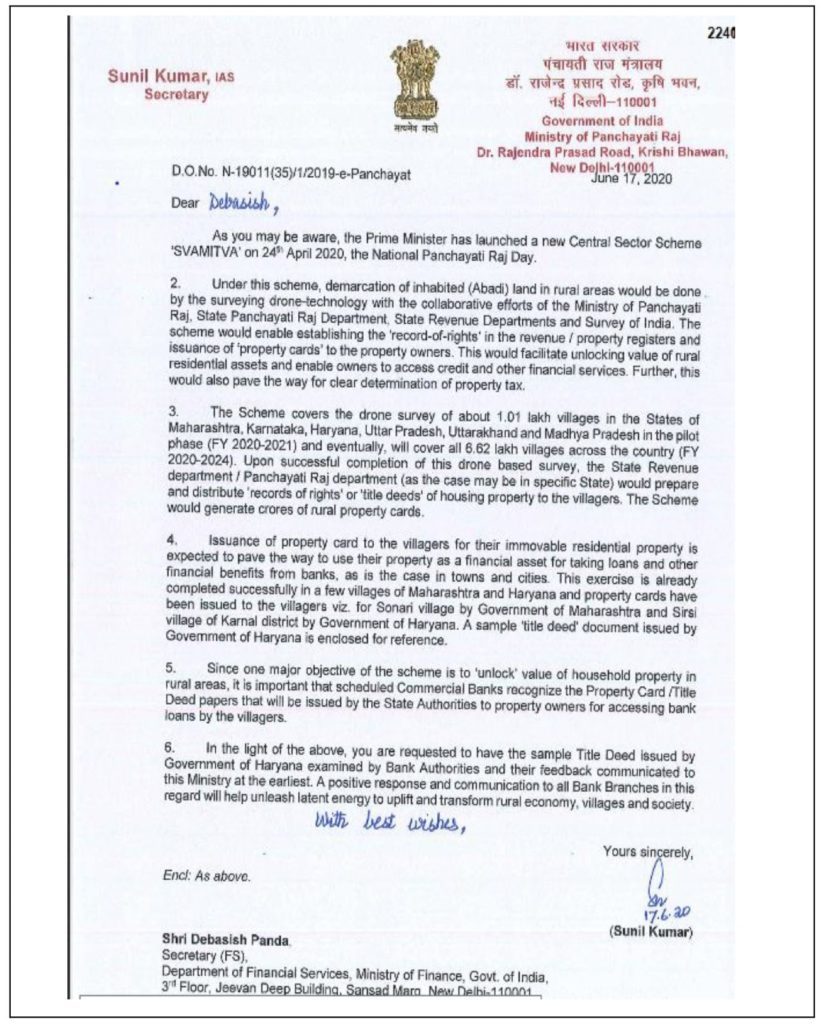
Source: Report of Expert Committee on SVAMITVA Scheme – Annexure V
The Framework for implementation of SVAMITVA Scheme (2021-25) also has guidelines for the state to ensure the recognition and legal sanctity of property cards.
The expert committee made a few more recommendations as listed below.
- Property cards to have a QR code or other unique identifier, which enables banks to verify the authenticity of the property card
- Every plot in Abadi land must be numbered and boundaries clearly defined, as the banks accept the property as security only when it is identifiable on the ground.
- State governments to notify guidance value for the Abadi area and update it periodically so that the banks can assess the value of the property.
- States to ensure no restriction in law on the selling of the Abadi property in case of default of the loan, as is done in the case of agricultural land.
Distribution of Cards completed for 43.7 thousand villages
As per SVAMITVA’s dashboard of the Ministry of Panchayat Raj, Property Card Distribution is completed in 43,763 villages, as on 16 November 2022. More than half of them are in Uttar Pradesh with 22.6 thousand villages. Other states with villages that have completed the process of issuing Property cards are Uttarakhand, Rajasthan, Madhya Pradesh, Karnataka, Haryana, and Gujarat along with the UT of Jammu & Kashmir. None of the other states have any villages which have completed the process. However, the Drone survey is initiated across all 31 States and UTs. As on 16 November 2022, Drone Surveys were initiated in a total of 1.97 lakh villages.

Featured Image: Report on SVAMITVA scheme


